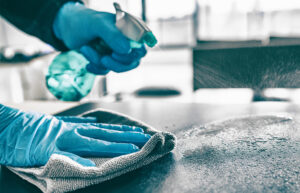Maintaining a sterile environment in the realm of healthcare is paramount. However, biofilms pose a significant challenge to this goal. A peer-reviewed article, “How biofilm changes our understanding of cleaning and disinfection”, discusses biofilm in healthcare settings
These complex microbial communities, classified as wet (hydrated) or dry surface biofilms (DSB), are common in healthcare settings and act as reservoirs for dangerous pathogens, including multi-drug resistant organisms. Understanding and controlling biofilms is crucial to reducing the risk of hospital-acquired infections.
What Are Biofilms?
Biofilms are collections of microorganisms surrounded by an extracellular polymeric matrix composed of proteins, lipids, enzymes, and DNA. This matrix protects the microbes within the biofilm, making them highly resistant to antimicrobials and disinfectants. Biofilms are found on various surfaces within healthcare facilities, such as medical devices, sinks, taps, and even dry surfaces like counters and equipment.


The Challenge of Biofilms in Healthcare
Biofilms present a formidable challenge in healthcare due to their resilience. Literature indicates that biofilms are significantly less susceptible to disinfection efforts. This resistance is due to several factors:
- Persister Cells: These cells allow biofilms to survive external threats and treatments.
- Quorum Sensing: A type of microbial communication that enables bacteria within the biofilm to collectively respond to environmental stresses.
- Multispecies Composition: Biofilms often contain a variety of pathogens, some of which may be highly resistant to disinfectants.
- Expression of Resistance Genes: Biofilms can activate genes that enhance their resistance to cleaning agents.
Dry Surface Biofilms vs. Hydrated Biofilms
Dry surface biofilms (DSB) are particularly challenging. Studies have shown that biocides such as benzalkonium chloride, peracetic acid, NaDCC, and sodium hypochlorite, combined with wiping, can significantly reduce the presence of DSB. However, only NaDCC and peracetic acid have been effective in not only reducing DSB but also preventing their cross-transmission to other surfaces.
Hydrated biofilms, commonly found in areas like sinks and drains, are also problematic. Laboratory studies replicating drain biofilms from healthcare settings revealed that biocides like NaDCC, peracetic acid, and sodium hypochlorite can achieve varying reduction levels.

Key Insights
- Prevalence: Biofilms, in both hydrated and dry forms, are widespread in healthcare settings.
- Necessity of Control: Effective biofilm control is essential, and strategies must be tailored to the specific type of biofilm.
- Education: Educating healthcare stakeholders, including infection control professionals, about biofilms is critical. Proper knowledge ensures the correct use of disinfectants and adherence to infection prevention programs.
Interesting Facts About Biofilms
- Biofilms are associated with chronic wounds, urinary catheter infections, and pneumonia and can even be found on medical devices.
- An estimated 65-80% of all bacterial and chronic infections are linked to biofilms.
- Up to 90% of sampled surfaces in healthcare environments may harbour dry surface biofilms.

Biofilms fundamentally alter our approach to cleaning and disinfection in healthcare settings. Their resistance to conventional disinfection methods necessitates ongoing research and education. By implementing targeted strategies to manage both hydrated and dry surface biofilms, healthcare facilities can significantly reduce the risk of hospital-acquired infections, ultimately leading to better patient outcomes and safer healthcare environments.
Klorkleen 2 (KK2)
Sodium dichloroisocyanurate (NaDCC) is an effective disinfectant widely used in various applications, including water treatment and surface disinfection. Its ability to penetrate biofilms—a structured community of microorganisms enclosed within a self-produced polymeric matrix—stems from several mechanisms:
Oxidative Action:
NaDCC releases hypochlorous acid (HOCl) in aqueous solutions, which is a powerful oxidizing agent. HOCl can oxidize and break down the extracellular polymeric substances (EPS) that protect and hold the biofilm together. This disruption of the EPS matrix allows NaDCC to penetrate deeper into the biofilm.

Chlorine Penetration:
The chlorine released from NaDCC can diffuse through the biofilm matrix. While the EPS can offer some resistance to penetration, the small molecular size and high reactivity of chlorine species enable them to reach the microbial cells within the biofilm.
pH Modulation:
NaDCC solutions can cause local changes in pH within the biofilm. These changes can enhance chlorine’s antimicrobial activity and increase the biofilm’s susceptibility to oxidative damage.
Contact Time and Concentration:
Prolonged contact time and higher concentrations of NaDCC improve its ability to penetrate and disrupt biofilms. The effectiveness depends on maintaining an adequate concentration of active chlorine for sufficient duration to affect the biofilm structure and the embedded microorganisms.

NaDCC’s penetration and efficacy against biofilms can be enhanced when combined with mechanical cleaning or other disinfectants. Mechanical actions can disrupt the biofilm structure, making it easier for NaDCC to infiltrate and exert its biocidal effects.
Effective biofilm control often requires combining chemical disinfection with physical cleaning methods to achieve comprehensive biofilm removal.
If you need advice on the benefits of NaDCC in healthcare facilities, reach out to our experts Chris Butler, chris.butler@kersia-group.com and Shane Stephens, shane.stephens@kersia-group.com

